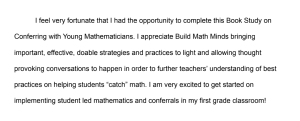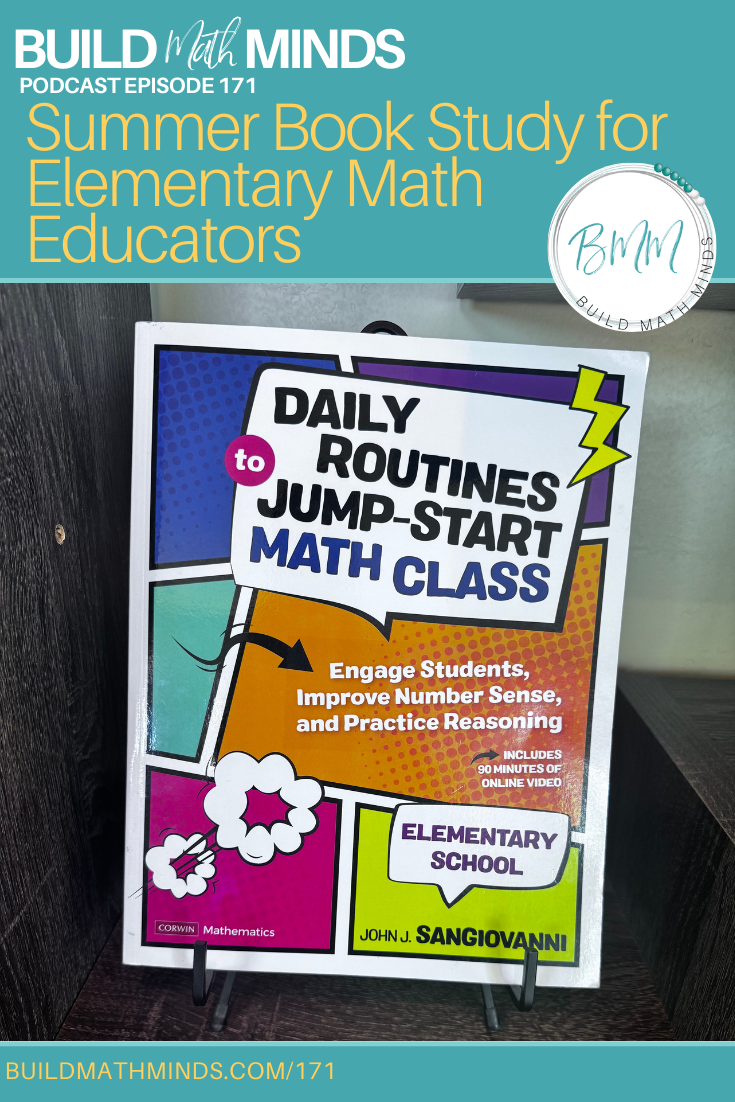Register for the Book Study: BuildMathMinds.com/bookstudy
Order the book (but register for the book study first to get the discount code emailed to you): https://us.corwin.com/books/daily-routines-elementary-268890
The youtube video for this episode
Welcome fellow Recovering Traditionalists to Episode 171: Summer Book Study for Elementary Math Educators
Before we get into the episode, this week’s positivity comes from a paper that was submitted about a book study we previously conducted.

We are gearing up for our 2024 Build Math Minds Summer Book Study for Elementary Math Educators and I would like to invite you to participate. The book study is free, you just need to register and of course purchase the book if you don’t already have it. Go to https://buildmathminds.com/bookstudy to register for the 5 week book study.
This will be my last episode until August and so I’m going to talk about the book that we are doing the summer book study on.
Daily Routines to Jump-Start Math Class by John SanGiovanni is a book full of ideas to use in your classroom. There is a book for different levels, but we will be using the one for Elementary School. I know you won’t have a classroom of kids to use the routines with but that’s not really the point of this book study.
During the book study we will NOT be investigating the different types of routines in the book because they are fabulous and there isn’t much to investigate. When school starts back up, just open up the book and start using the routines. He gives examples for different math concepts throughout elementary school for each routine so no matter what grade level you will be teaching in the Fall, you can use the routines in this book.
The routines are Part 2 in the book. During the 5 weeks of the book study we will be looking at Part 1 and Part 3 of the book. Essentially we will look at why we should be using math routines and how to make it actually possible to do in your classroom. Here’s what we will be delving into through the book study starting on July 8th:
Week 1 – What NOT to do For The First Few Minutes of Class and How You Can Have Better Student Engagement
Week 2 – What is a Routine: Key Features of Routines
Week 3 – The Power of Routines: How Routines Improve Number Sense, Reasoning, and Develop Math Fluency
Week 4 – How to Plan for & Implement Math Routines You Will Actually Do When School Starts
Week 5 – Modifying & Designing Your Own Routines to Meet the Needs of YOUR Students
Each week I’ll be sending out a video by Rosalba Serrano, myself, or it might have both of us in the video. You can watch the video on your own time and then respond to the journal prompts for that week of the book study. We will also have a spot inside a Facebook group for you to reply to the journal prompts so that you can interact with people who are also doing the book study.
Once you register for the 2024 Build Math Minds Summer Book Study for Elementary Math Educators, I’ll send you an email with the details along with a link to purchase the book and a discount code from our friends at Corwin, who is the publisher of John’s book. To give you a push to join us this summer for the book study here is a piece from the book on page 1 about why we should be taking a look at using Routines to Jump-Start Math Class:
“THE FIRST FEW MINUTES OF MATHEMATICS CLASS
The start of an elementary mathematics class varies greatly from classroom to classroom, grade to grade, and school to school. It might be a mad rush to get our students settled as they come into the room in the morning, from recess, or from related arts. It might be a blurred start as we change topics from science or social studies to mathematics. It might be the first few minutes of our instructional day, or it might be the last hour of our day. Regardless of how or when it begins, the first few minutes of our mathematics class has the potential to shape the entire lesson by setting tone and purpose.
The first few minutes are an opportunity for us to capture the attention of our students and prepare them for the lesson ahead. These opening minutes are also the time when our students’ brains are freshest. They tend to remember more of what we teach or do during this segment than any other time of the learning episode (Sousa, 2007). That is why it is such a critical time for us to help students shed their distractions, capture their attention, and jump-start their brains. Engaging students immediately will increase the likelihood that they’ll stay engaged and motivated to learn throughout the lesson.
However, we don’t always take advantage of those precious first few minutes. We have felt obligated to meet the long-held traditions about how mathematics class must begin. We have come to find that the activities instead undermine our goals and the productive beliefs we have about teaching and learning mathematics. First, and foremost, we have all experienced our instructional time being hijacked by opening calendar rituals, traditional warm-ups, and homework review. It is difficult to keep each of these from going beyond the allotted time. We have had them unravel, becoming unwanted mini-lessons disconnected from the intended objective because we want to help our students. These opening activities also often focus on the goal of getting right answers. They cause us to begin class by setting the tone that mathematics is the pursuit of answers.”
If you want to start your math time with a powerful way to engage your students that helps them develop number sense, reasoning skills, and build their math fluency join us in the book study this summer to learn how to use Routines to Jump-Start your math time. Go to https://buildmathminds.com/bookstudy to register for the 5 week book study.
I usually say “Until next week my Fellow Recovering Traditionalists”, but I’m taking a break during summer with these episodes so I’ll be back in August to help you Build your Math Mind so you can Build the Math Minds of your students next year.




